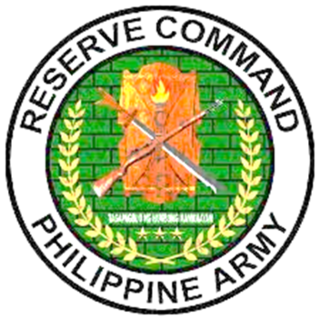
The Armed Forces of the Philippines (AFP) are the military forces of the Philippines. It consists of three main service branches; the Army, the Air Force, and the Navy. The President of the Philippines is the Commander-in-Chief of the AFP and forms military policy with the Department of National Defense, an executive department acting as the principal organ by which military policy is carried out, while the Chief of Staff of the Armed Forces of the Philippines serves as the overall commander and the highest-ranking officer in the AFP.

Isabela, officially the Province of Isabela, is the second largest province in the Philippines in land area located in the Cagayan Valley. Its capital and the largest local government unit is the city of Ilagan. It is bordered by the provinces of Cagayan to the north, Kalinga to the northwest, Mountain Province to the central-west, Ifugao and Nueva Vizcaya to the southwest, Quirino, Aurora and the independent city of Santiago to the south, and the Philippine Sea to the east.

Isabela, officially the City of Isabela, is a 4th class component city (separate) and de facto capital of the province of Basilan, Philippines. According to the 2020 census, it has a population of 130,379 people.

Ilagan, officially the City of Ilagan, is a 1st class component city and capital of the province of Isabela, Philippines. According to the 2020 census, it has a population of 158,218 people making it the most populous city in the province. As of 2022, it holds the title as the most number of voters in the province with 101,050 electorates.

Juan Cailles y Kauppama was a Filipino general and politician. A member of the revolutionary movement Katipunan, he was a commanding officer of the Philippine Revolutionary Army who served during the Philippine Revolution and Philippine–American War. He later served as a provincial governor of Laguna and a representative from Mountain Province.

Gamu, officially the Municipality of Gamu, is a 4th class municipality in the province of Isabela, Philippines. According to the 2020 census, it has a population of 30,655 people.

The Philippine Republic, now officially remembered as the First Philippine Republic and also referred to by historians as the Malolos Republic, was established in Malolos, Bulacan during the Philippine Revolution against the Spanish Empire (1896–1898) and the Spanish–American War between Spain and the United States (1898) through the promulgation of the Malolos Constitution on January 22, 1899, succeeding the Revolutionary Government of the Philippines. It was formally established with Emilio Aguinaldo as president. It maintained governance until April 1, 1901.

Cesar Basa Air Base, or simply Basa Air Base, is an airbase currently operated by the Philippine Air Force. It is located at Floridablanca, Pampanga about 40 miles (64 km) northwest of Metro Manila in the Philippines. It is named after César Basa, one of the pioneer fighter pilots of the Philippine Air Force.

The Philippines–United States relations refers to the bilateral and diplomatic relations of the Republic of the Philippines and the United States of America. The relationship between the United States and the Philippines has been historically strong; often described as a "special relationship," originating from the fact that the Philippines was a colony of the United States between 1898 and 1946. The former Philippine president Rodrigo Duterte, however, was supportive of a foreign policy that was less dependent on the United States, favoring one that prioritized closer relations with China and Russia, despite the Philippines and the U.S. having a mutual defense treaty dating from 1951 to the present. In 2014, the countries signed an enhanced defense cooperation agreement that began its first phase of implementation in 2019.

The Northern Luzon Command is the Armed Forces of the Philippines' unified command in charge of the Ilocos Region, Cordillera Administrative Region, Cagayan Valley and Central Luzon, including the Scarborough Shoal and the Benham Rise. It is responsible for the defense of these areas against external aggression, as well as combating terrorism and insurgency.

The 5th Infantry Division, Philippine Army, known officially as the Star Division, is the Philippine Army's primary infantry unit in Northern Luzon, and specializes in anti-guerrilla warfare.

The Reserve Command is a major support command of the Philippine Army. It was created for the sole purpose of reserve force management, organization and Government Arsenal procurement.

Jose T. Almonte is a retired Filipino Army general. He was the National Security Advisor and Director-General of the National Security Council in the Cabinet of Philippine President Fidel V. Ramos. He was also the head of the National Intelligence Coordinating Agency and the Director of the Economic Intelligence and Investigation Bureau (EIIB) during the administration of Pres. Corazon Aquino.

The Philippine Air Force (PAF) is the aerial warfare service branch of the Armed Forces of the Philippines. Initially formed as part of the Philippine Army, the PAF is responsible for both defending the Philippine airspace, and conducting aerial operations throughout the Philippines, such as close air support operations, combat air patrols, aerial reconnaissance missions, airlift operations, helicopter tactical operations and aerial humanitarian operations. The PAF is headquartered at the Villamor Air Base in Pasay, and is headed by the Chief of the Air Force, who also serves as the branch's highest-ranking military officer.
The Enhanced Defense Cooperation Agreement (EDCA) is an agreement between the United States and the Philippines intended to bolster the American–Philippine alliance. The agreement allows the United States to rotate troops into the Philippines for extended stays and allows the United States to build and operate facilities on Philippine bases for both American and Philippine forces. The U.S. is not allowed to establish any permanent military bases. The Philippines have personnel access to American ships and planes. This agreement has been the subject of criticism by some leftist groups in the Philippines.

The Alex Boncayao Brigade was the urban assassination unit of the New People's Army, the armed wing of the Communist Party of the Philippines. Organized in 1984, the unit broke away from the New People's Army as a consequence of a split in ideology during the 1990s. In 1997, the Alex Boncayao Brigade allied itself with the Revolutionary Proletarian Army, the armed wing of the Revolutionary Workers' Party.
The kidnapping of Angelo dela Cruz, a Filipino Overseas Filipino Worker working in Iraq, is an event that led to the withdrawal of Filipino soldiers from the Multi-National Force – Iraq, a United States-led multinational coalition which was a participant in the Iraq War.
On November 8, 2022, the Philippine Army and the Moro Islamic Liberation Front (MILF) engaged in a gunfight in Ungkaya Pukan, Basilan, while the army was conducting clearing operations on "lawless elements" allegedly taking refuge in the territory controlled by the MILF. Fighting between the two sides continued until November 10, 2022 when a ceasefire between two sides were signed.

















